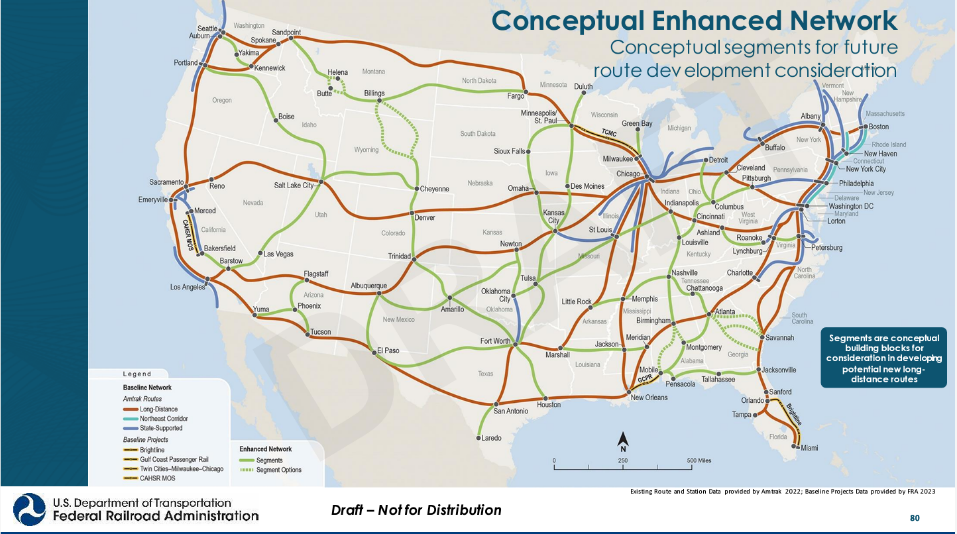Amtrak train rolls through the Midwest
August 08, 2023
Dreaming of a Rail Renaissance
Amtrak's long-distance passenger rail network provides millions of Americans with transportation options other than a personal vehicle. For the first time in 50 years, we can seriously consider an expansion.
As part of the Bipartisan Infrastructure Bill, Congress directed the Federal Railroad Administration (FRA) to study the feasibility of expanding Amtrak’s long-distance passenger rail network.

Conceptual Enhanced Network of Amtrak’s long distance passenger rail – Federal Railroad Administration
Given Amtrak’s history, this requirement is nothing short of remarkable. Ever since Amtrak’s creation, long distance passenger rail service has been under threat. The day Amtrak began service, routes all across the country were cancelled. And over the next 50 years, pressure from Congress and various Administrations led to additional cuts. This culminated under the George W. Bush Administration, when DOT Secretary Norm Mineta publicly called for forcing Amtrak into bankruptcy.
The Long-Distance Service Study presents an opportunity to establish and bolster essential intercity passenger rail connections and build a stronger rail network overall—one that would allow people to get where they need to go safely and efficiently.
In some communities, long-distance trains are the only common carrier passenger transportation option available, and the long-distance network provides millions of Americans with transportation options other than a personal vehicle.
In some communities, long-distance trains are the only common carrier passenger transportation option available.
ELPC recently participated in a regional working group meeting and was briefed about the progress of the study including, methodology for developing an enhanced long-distance rail network – representing a wide range of possibilities for further consideration in developing potential new long-distance routes – and provided input on the proposed enhanced networks.
Their preliminary results are impressive
The proposed enhanced rail network would:
- Decrease by half the number of Americans not served by passenger rail;
- Decrease by 60% the number of urban dwellers without Amtrak access;
- Increase by 52% the number of rural Americans with Amtrak access;
- Expand Amtrak’s footprint to 46 of the 48 contiguous states and to 332 Congressional districts.
- Increase by 60% the number of disadvantaged Americans with Amtrak access;
- Double Amtrak access to tribal lands;
- Connect an additional 600 colleges and universities and their 2 million students.
Here’s what this could look like in the Midwest. Expanding our passenger rail network would increase access to rural, tribal, and urban communities throughout the region. Would you like the option to take a train from Duluth to Des Moines or Cleveland to Cincinnati or other new connections?

Midwest closeup map highlights rural accessibility in the Conceptual Enhanced Network map for Amtrak – Federal Railroad Administration
It’s important that FRA hear from others regarding the information presented and the progress of this study. ELPC will be submitting detailed feedback. I encourage you to review project information and meeting materials on the project website: www.fralongdistancerailstudy.org and submit comments via the webform at the bottom of the homepage, or to the project inbox at [email protected]. Please send them any comments on the most recent meeting materials by Monday, August 21.
This is the first time in 50 years we’ve had a chance to seriously consider an Amtrak expansion. Let’s seize the opportunity.


